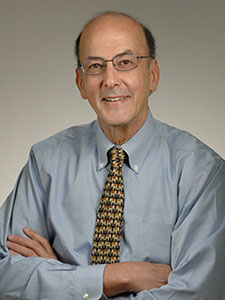Pandemic truths: “none are safe until all are safe”
January/ February 2022 | Volume 21 Number 1
In the hundred years since the great influenza pandemic of 1918, little has changed in terms of basic control measures — masking and social distancing. Yet the introduction of new science has been momentous for diagnostics, global tracking and modeling, new drugs and, of course, vaccines. During the current SARS-CoV-2 pandemic, more than 9 billion doses of COVID-19 vaccine have been manufactured and administered in little over a year, a remarkable achievement.
 Read recent
opinion pieces from Fogarty Director Dr. Roger I. Glass. Yet, the distribution of these vaccines highlights the troubling issue of global inequities. Only 8% of vaccines have gone to Africa, the second most populous continent on earth. The 55 constituent countries of the African Union not only depend on the international community for vaccines but also diagnostics, drugs and PPE. Last April, the African Union, the African CDC and the Coalition for Epidemic Preparedness Innovations (CEPI) launched Partnerships for Vaccine Manufacturing in Africa, which, among other goals, aims to locally produce 60% of vaccines by 2040, while developing African universities as R&D hubs.
Read recent
opinion pieces from Fogarty Director Dr. Roger I. Glass. Yet, the distribution of these vaccines highlights the troubling issue of global inequities. Only 8% of vaccines have gone to Africa, the second most populous continent on earth. The 55 constituent countries of the African Union not only depend on the international community for vaccines but also diagnostics, drugs and PPE. Last April, the African Union, the African CDC and the Coalition for Epidemic Preparedness Innovations (CEPI) launched Partnerships for Vaccine Manufacturing in Africa, which, among other goals, aims to locally produce 60% of vaccines by 2040, while developing African universities as R&D hubs.
Undoubtedly, the pandemic has been a wake-up call. Still, there are many reasons for hope. I recently visited Rwanda, where I was heartened to see lower rates of COVID in Kigali than in many places in the U.S. People wore masks everywhere and free screening was widespread. This country of just under 13 million had vaccinated more than 90% of its Kigali population, and 70% nationwide.
Another reason for optimism: international collaboration has characterized this pandemic from the start. The open science spirit began with the Chinese publishing in January 2020 the first SARS-CoV-2 sequence, which served as the blueprint for most vaccines. Since then, scientists have posted more than three million genomic sequences on open international databases.
Only three African sites had the ability to sequence strains in the earliest weeks of the pandemic, yet training—some of which was provided by Fogarty and its partners—has helped enable sequencing of more than 60,000 African strains to date. Just as international data sharing is currently possible, global surveillance can soon become a reality.
One positive lesson from COVID has been the importance of investing in people. Many foreign scientists trained by NIH and Fogarty programs are leaders in their country’s pandemic response: Dr. John Nkengasong, who leads the African CDC; Dr. Christian Happi, who sequenced the first SARS-CoV-2 strain identified in Nigeria; and Dr. Sikhulile Moyo, who discovered the omicron variant in Botswana. We never anticipated their training, which has enabled them to adapt and address the pandemic, would be so valuable. Developing leaders in Africa, incubating their talents and building on them will be essential activities going forward.
Throughout the pandemic, global partners—including WHO, CEPI and the Global Alliance for Vaccines and Immunizations (GAVI)—have demonstrated best practices in fostering a global response. Free exchange of ideas helped us all conclude that new vaccines, to be most effective, need to be distributed worldwide within 100 days. If we accelerate research on the 20-plus major virus groups, we can develop prototype vaccines and drugs for each class well in advance of future outbreaks. We also need regional centers for local production of vaccines, drugs, supplies and devices; this necessitates establishing supply chains with multiple providers for key ingredients.
The past two years have revealed to every person—and every world leader—the shortcomings of global outbreak preparation and response. Each of us now sees that “none are safe until all are safe.” Our global society can seize this moment by establishing more effective governance and improving partnerships between industry, universities, financial institutions and philanthropic foundations. Most importantly, we must address inequities within existing and proposed systems.
These goals are not fantasies. Another tragic pandemic, HIV/AIDS, also provided lessons—lessons we studied and learned. No longer an automatic death sentence, HIV is now a chronic disease thanks to the many collaborative scientific discoveries funded by global partnerships. With sufficient investment and a concerted global effort, we can ensure we are better prepared when the next pandemic strikes.
More Information
- Video:
The global challenge: COVID and Future Pandemics
lecture by Roger I. Glass, Director of Fogarty International Center
Demystifying Medicine, January 4, 2022, NIH Videocast.
-
Two years of COVID-19 in Africa: lessons for the world
authored by Fogarty grantees Christian T. Happi and John Nkengasong
Nature, January 3, 2022 -
Building global health research capacity to address research imperatives following the COVID-19 pandemic
authored by Peter H. Kilmarx, Deputy Director of Fogarty International Center and Roger I. Glass, Director of Fogarty International Center
PLOS Medicine, August 31, 2021 -
The COVID-19 pandemic provides an opportunity to reimagine preparedness for and responses to future pandemics
authored by John Nkengasong, Director African Centers for Disease Control and former Fogarty trainee
Nature Medicine, March 15, 2021
To view Adobe PDF files,
download current, free accessible plug-ins from Adobe's website.